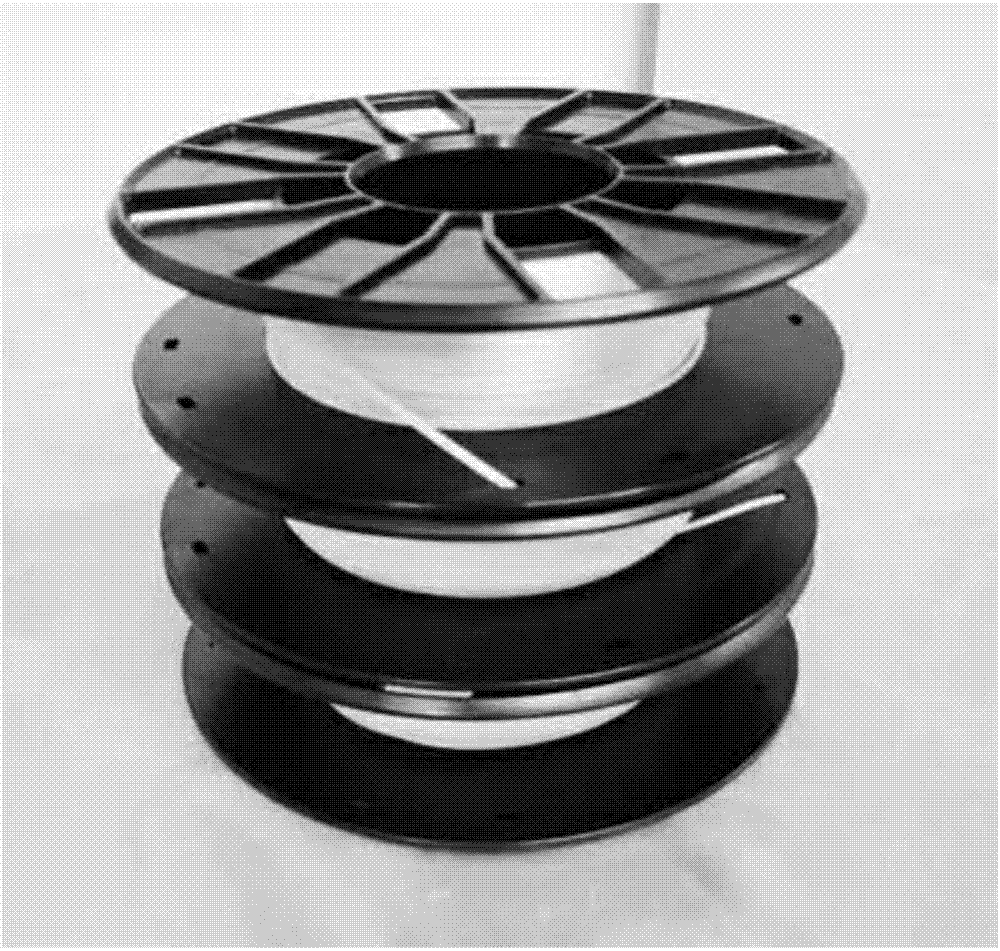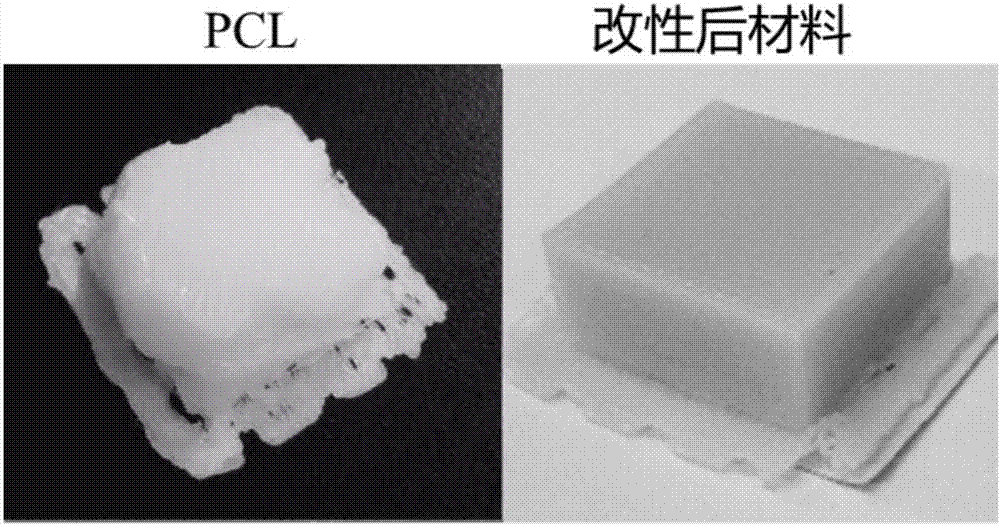Low-temperature FDM (Fused Deposition Modeling) biomedical degradable 3D (three-dimensionally) printing material, preparation and application
A biomedical and 3D printing technology, applied in the field of 3D printing, can solve the problems of limiting the popularization of low-temperature 3D printing materials, low melt strength, complicated operation, etc., and achieves the advantages of simple and easy preparation method, good printing performance and low preparation cost Effect
- Summary
- Abstract
- Description
- Claims
- Application Information
AI Technical Summary
Problems solved by technology
Method used
Image
Examples
Embodiment 1
[0027] Weigh 80g of PCL masterbatch and place it in a 250mL beaker, then weigh and add 5g of cornstarch, 5g of EBS, 5g of SiO 2 and 5 g of magnesium stearate. Use a mixer to mix it well.
[0028] Put the mixture in a twin-screw extruder, and fully blend the PCL and the filler by means of melt blending. Set the temperature of zone 1, zone 2, zone 3 and zone 4 of the twin-screw extruder to 50, 75, 100 and 75°C, respectively. Set the screw speed at 20 rpm. After the blending is completed, the prepared materials are pulverized and granulated.
[0029] The prepared pellets are melted and extruded by a single-screw extruder, and pulled by a tractor to form a wire with uniform size. Set the temperature of the first zone and the second zone of the single-screw extruder to 80°C and 85°C respectively, the screw speed to 30rpm, and the wire size to 1.70-1.75mm.
[0030] When printing with an FDM 3D printer, set the 3D printer parameters as follows: nozzle temperature 85°C, bottom pl...
Embodiment 2
[0032] Weigh 82g of PCL masterbatch and place it in a 250mL beaker, then weigh and add 8g of potato starch, 2g of EBS, 3g of SiO 2 and 5 g of magnesium stearate. Use a mixer to mix it well.
[0033] Put the mixture in a twin-screw extruder, and fully blend the PCL and the filler by means of melt blending. The temperatures of the first zone, the second zone, the third zone and the fourth zone of the twin-screw extruder were respectively set to 60, 75, 90 and 75°C. Set the screw speed at 20 rpm. After the blending is completed, the prepared materials are pulverized and granulated.
[0034] The prepared pellets are melted and extruded by a single-screw extruder, and pulled by a tractor to form a wire with uniform size. Set the temperature of the first zone and the second zone of the single-screw extruder to 80°C and 85°C respectively, the screw speed to 30rpm, and the wire size to 1.70-1.75mm.
[0035] When printing with an FDM 3D printer, set the 3D printer parameters as fo...
Embodiment 3
[0037] Weigh 84g of PCL masterbatch and place it in a 250mL beaker, then weigh and add 6g of soluble starch, 4g of EBS, 3g of SiO 2 and 3 g of magnesium stearate. Use a mixer to mix it well.
[0038] Put the mixture in a twin-screw extruder, and fully blend the PCL and the filler by means of melt blending. Set the temperature of zone 1, zone 2, zone 3 and zone 4 of the twin-screw extruder to 50, 70, 90 and 75°C, respectively. Set the screw speed at 15 rpm. After the blending is completed, the prepared materials are pulverized and granulated.
[0039] The prepared pellets are melted and extruded by a single-screw extruder, and pulled by a tractor to form a wire with uniform size. Set the temperature of the first zone and the second zone of the single-screw extruder to 80°C and 85°C respectively, the screw speed to 40rpm, and the diameter of the wire to be 1.70-1.75mm.
[0040] When printing with an FDM 3D printer, set the 3D printer parameters as follows: nozzle temperature ...
PUM
| Property | Measurement | Unit |
|---|---|---|
| Size | aaaaa | aaaaa |
| Diameter size | aaaaa | aaaaa |
Abstract
Description
Claims
Application Information
 Login to View More
Login to View More - R&D
- Intellectual Property
- Life Sciences
- Materials
- Tech Scout
- Unparalleled Data Quality
- Higher Quality Content
- 60% Fewer Hallucinations
Browse by: Latest US Patents, China's latest patents, Technical Efficacy Thesaurus, Application Domain, Technology Topic, Popular Technical Reports.
© 2025 PatSnap. All rights reserved.Legal|Privacy policy|Modern Slavery Act Transparency Statement|Sitemap|About US| Contact US: help@patsnap.com


